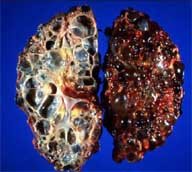Renal enlargement

Patient with bilateral renal enlargement are commonly shown in PACES. The causes would be:
1. Polycystic kidney disease (very common and almost 100% in PACES)
2. Bilateral hydronephrosis (rare in PACES)
3. Amyloidosis (rare)
Having diagnosed a mass as a kidney, you must be able to support this with your physical findings:
1. Ballotable ( ask patient to inspirate and hold the breath)
2. Resonant to percussion
3. Examining hand can get between swelling and costal margin
4. Slight movement downwards on inspiration
Unilateral renal enlargement is less common in PACES.
1. Nephrectomy in polycystic kidney ( look for scar!)
2. Renal cysts
3. Carcinoma
4. Hydronephrosis
5. Hypertrophy of a single functioning kidney
**Remember, should you encounter a kidney case in PACES, 50% of them are polycystic kidney and the other 50% would be renal transplant!
**Dont mistaken hepatosplenomegaly as bilateral kidney mass and vice versa.
Labels: Abdomen








0 Comments:
Post a Comment
<< Home